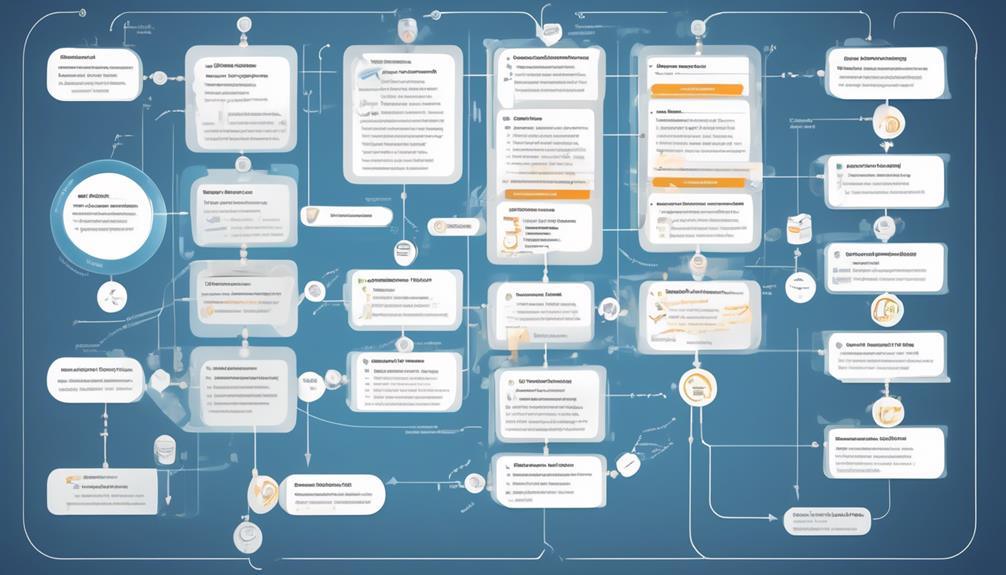As I journey through the intricate realm of quality assurance, I can’t help but draw comparisons to a ship navigating through unpredictable waters. Just like a captain depends on a carefully crafted risk management plan to steer clear of possible obstacles, QA teams must also make risk management a top priority to ensure the success of a project.
However, the question remains: why is risk management so vital for QA success? The answer lies in the potential impact that unmanaged risks can have on the integrity and reliability of a project.
Join us as we explore the critical role that risk management plays in the world of quality assurance and how it can make or break the outcomes of software development and testing.
Key Takeaways
- Accurate risk identification enables prioritization of risks based on their potential impact on quality and performance.
- Effective risk identification facilitates the development of targeted mitigation strategies, reducing the likelihood and impact of potential quality risks.
- By embracing quality risk management, QA can evolve from a reactive role to a strategic partner in driving business success.
- Meticulous documentation and clear communication are crucial for successful risk management in QA.
Understanding Quality Assurance Risks
When assessing quality assurance risks, we must actively identify and manage potential negative events to ensure software quality. Risk management in QA involves evaluating the likelihood and impact of adverse occurrences on the quality of software. Testers play a pivotal role in accurately pinpointing and addressing risks during the testing phase. Heightened awareness of risks is essential for effective quality risk management, as it enables proactive problem-solving and mitigates potential failures. It's crucial to adopt a proactive approach to risk management in QA, addressing and preventing risks before they escalate, rather than responding reactively to high-profile outages.
Effective risk management in quality assurance is indispensable for minimizing the potential impact of risks, ensuring product quality, and optimizing resource allocation. By actively identifying and managing potential negative events, we can enhance the overall quality of the software. Understanding the nuances of quality assurance risks is fundamental to laying a strong foundation for successful risk management in QA.
Importance of Risk Identification

Identifying potential risks is a critical aspect of effective risk management in Quality Assurance (QA). Accurate risk identification allows us to prioritize and develop mitigation strategies, minimizing potential negative impacts on software quality and performance. By being proactive in identifying and managing potential risks in the testing process, QA teams can transition from a reactive function to a strategic partner in business success.
| Importance of Risk Identification | |
|---|---|
| 1. Prioritization | Accurate risk identification enables prioritization of risks based on their potential impact on quality and performance, allowing for focused mitigation efforts. |
| 2. Mitigation Strategies | Effective risk identification facilitates the development of targeted mitigation strategies, reducing the likelihood and impact of potential quality risks. |
| 3. Minimizing Negative Impacts | Through proactive risk identification, QA teams can minimize the negative impacts on software quality and performance, enhancing overall product reliability. |
| 4. Strategic Partnership | By embracing quality risk management, QA can evolve from a reactive role to a strategic partner in driving business success, contributing to overall organizational resilience and growth. |
Effective risk identification is fundamental to achieving quality risk management and ensuring the success of QA processes.
Prioritizing Risks in QA
As we move on to prioritizing risks in QA, we'll be looking at various techniques for risk identification, methods for assessing the impact of these risks, and strategies for mitigating them.
It's crucial that we gather insights from all stakeholders and team members to ensure we prioritize risks based on the criticalness of the system, regulatory requirements, customer impact, and business objectives.
Risk Identification Techniques
Engaging with stakeholders, QA team members, and developers is an essential step in gathering insights on potential risks for prioritizing in QA.
To effectively identify and prioritize risks in QA, we employ various techniques such as:
- Analyzing the criticalness of the system
- Considering regulatory requirements
- Evaluating potential customer impact
- Aligning with business objectives
- Documenting each risk with its description, potential impact, and likelihood of occurrence
Impact Assessment Methods
To effectively prioritize risks in QA through impact assessment methods, we analyze the potential consequences and likelihood of occurrence, building on insights gathered from stakeholders, QA team members, and developers in the risk identification process.
Prioritizing risks based on criticalness of the system, regulatory requirements, customer impact, and business objectives is crucial in impact assessment methods.
Effective implementation of mitigation measures and continuous assessment of the status of risks are integral parts of risk management.
Impact assessment methods help minimize the impact of potential risks, improve product quality, reliability, and optimize resource allocation and testing efforts.
Risk Mitigation Strategies
Effective risk mitigation strategies in QA involve prioritizing risks based on critical system components, regulatory requirements, customer impact, and business objectives. When prioritizing risks in QA, the following measures should be considered:
- Engage stakeholders, team members, and developers to gather insights on potential risks.
- Clearly communicate responsibilities to QA team members and stakeholders for effective risk mitigation.
- Regularly monitor and review risk mitigation measures to ensure successful implementation.
- Document identified risks, assessments, mitigation strategies, and implementation status for maintaining a central repository.
- Utilize the criticalness of the system, regulatory requirements, customer impact, and business objectives as factors for prioritizing risks in QA.
Implementing these risk mitigation strategies is crucial for effective risk management and ensuring the success of QA processes.
Analyzing Quality Assurance Risks

We need to focus on identifying potential risks in our quality assurance processes to ensure the success of our testing efforts.
Mitigating vulnerabilities in our testing procedures is essential for maintaining the integrity of the software we deliver.
We should also prioritize proactive risk assessment to anticipate and address potential issues before they impact our projects.
Identifying Potential QA Risks
Accurately identifying potential QA risks is a critical step in ensuring the overall quality and success of software products. In the realm of risk management, the QA team must diligently assess and prioritize potential risks to mitigate their impact.
Here are five key aspects to consider when identifying potential QA risks:
- Assessing the likelihood and potential damage of an event
- Judging the importance of problems and implementing preventive measures
- Heightened risk awareness for quality risk management
- Stakeholder awareness of potential damage caused by risk
- Proactive approach in addressing and preventing risks
Mitigating Testing Vulnerabilities
Mitigating testing vulnerabilities in quality assurance involves proactive risk assessment and strategic planning to ensure the reliability and security of software products.
Identifying and prioritizing risks requires engaging stakeholders, QA team members, and developers to document each risk's potential impact and likelihood of occurrence.
Implementing risk mitigation measures, communicating responsibilities, and regularly reviewing strategies are crucial aspects of risk management in QA teams. This approach minimizes the impact of potential risks, improves product quality and reliability, ensures software security, and optimizes resource allocation and testing efforts.
Best practices in risk management encompass continuous risk identification, adaptive planning, and involving stakeholders in risk assessment.
Testing is essential for reducing various types of risks in business, making QA and testing vital components of risk management, contributing to risk prevention and mitigation.
Proactive Risk Assessment
How can proactive risk assessment in quality assurance help minimize the impact of potential risks on software quality and reliability?
Proactive risk assessment allows QA teams to anticipate and mitigate potential risks before they affect software quality. In this process, management plays a critical role in ensuring that risks are accurately identified and managed.
To achieve successful proactive risk assessment, it's essential to assess the likelihood and potential damage of potential risks, enabling effective risk management. Additionally, judging the importance of identified problems and implementing preventive measures are vital steps in proactive risk assessment.
Developing Mitigation Strategies

To effectively address potential risks in QA, it's essential to develop tailored mitigation strategies that minimize their impact on software quality. Developing mitigation strategies in risk management involves creating plans to minimize the impact of potential risks on software quality. These strategies should be customized to address specific project risks and challenges in QA.
Proactive problem-solving through risk management includes predicting potential issues and taking decisive action with mitigation strategies. It's crucial to judge the importance of problems, implement preventive measures, and evaluate the process to ensure effective risk management in QA.
Mitigation strategies should aim to reduce the severity of risks and ensure the integrity and reliability of the project. By developing and implementing effective mitigation strategies, QA teams can significantly reduce the negative impact of potential risks on software quality, leading to smoother project outcomes and improved overall success.
Implementing Risk Mitigation Measures

After developing tailored mitigation strategies to address potential risks in QA, the next crucial step is to ensure clear communication and assignment of responsibilities for implementing risk mitigation measures. This ensures that everyone involved understands their roles and responsibilities in managing risks effectively.
Here are five key measures to consider when implementing risk mitigation strategies in QA:
- Regularly monitor and review the progress of risk mitigation measures, taking proactive action to address any deviations or issues.
- Maintain a central repository for easy accessibility of risk-related information and updates, including documented risks, assessments, and mitigation strategies.
- Continuously assess the status of risks, evaluate the success of strategies, track potential new risks, and periodically review and update the risk management plan.
- Analyze past projects for mistakes and lessons learned, develop new risk management solutions, and continuously improve risk management processes.
Monitoring and Reviewing Risks

Regularly reviewing and updating the risk registers is crucial for maintaining effective monitoring and reviewing of risks.
Engaging with stakeholders and team members to gather insights on potential risks is vital for identifying and prioritizing risks. This collaborative approach ensures that all perspectives are considered, enhancing the comprehensiveness of risk management.
Communicating responsibilities to team members and stakeholders is essential for implementing risk mitigation measures. It fosters accountability and ensures that everyone understands their role in managing risks, promoting a proactive risk management culture.
Documenting identified risks, assessments, mitigation strategies, and implementation status is important for effective risk management. It provides a clear record of the risk management process, facilitating transparency and accountability.
Additionally, analyzing past projects for mistakes and lessons learned, and continuously improving risk management processes are essential for proactive problem-solving. This reflective approach enables the integration of best practices and the avoidance of previously encountered pitfalls, contributing to ongoing quality assurance and risk management excellence.
Documenting Risk Management

Documenting risk management is a critical aspect of ensuring thorough and effective quality assurance processes in software development and testing. When it comes to risk management for QA, meticulous documentation is essential for success.
Here are five key aspects to consider when documenting risk management:
- Identification and Assessment: Clearly document the process of identifying and assessing potential risks in software development and testing. This ensures that all potential risks are thoroughly evaluated.
- Risk-Based Testing Approach: Document the adoption of a Risk-Based Testing (RBT) approach, particularly for complex and critical systems, limited resources, changing requirements, and regulatory compliance. This approach allows for a more targeted and efficient testing process.
- Steps for Effective Risk Management: Document the specific steps involved in effective risk management within QA teams, including identifying and defining risks, prioritizing risks, assessing and analyzing risks, developing risk mitigation strategies, and utilizing risk management software.
- Communication and Accountability: Documented risk management facilitates communication, ensures accountability, and provides a central repository for easy accessibility and regular updates.
- Continuous Improvement: Documenting risk management aids in analyzing past projects, developing new risk management solutions, and continuously improving risk management processes. This documentation serves as a valuable resource for future projects and process enhancements in QA.
Communication in Risk Management

As we consider the importance of communication in risk management, it's crucial to highlight the significance of clear team communication and timely risk reporting.
Engaging with stakeholders and team members to gather insights on potential risks plays a pivotal role in effective risk management.
Prioritizing risks based on critical system factors, regulatory requirements, and customer impact is vital for successful risk mitigation.
Clear Team Communication
Effective team communication is crucial for successful risk management in QA. This includes ensuring that all team members are informed about potential risks and mitigation strategies. Clear and open communication within the QA team and with stakeholders is essential for identifying, prioritizing, and addressing risks in the software development and testing process. It enables the team to implement risk mitigation measures effectively, clearly communicate responsibilities, and monitor progress.
Additionally, documenting identified risks, assessments, and mitigation strategies facilitates transparent and accessible risk-related information for the entire team. Open communication also allows for learning from past projects and mistakes, leading to continuous improvement in risk management processes within the QA team.
In summary, the key aspects of effective team communication for risk management in QA include:
- Open and transparent communication within the QA team and with stakeholders
- Identification, prioritization, and addressing of risks
- Implementation of effective risk mitigation measures
- Clear communication of responsibilities and progress monitoring
- Documentation of risks, assessments, and mitigation strategies.
Timely Risk Reporting
Timely risk reporting plays a crucial role in effective risk management for QA, ensuring prompt identification and resolution of potential risks. It involves regular and clear communication of identified risks, their potential impact, and proposed mitigation strategies to relevant stakeholders.
By reporting risks in a timely manner, QA teams can facilitate proactive problem-solving and decision-making, minimizing the potential impact on software quality. This approach maintains transparency, fosters collaboration, and ensures that risk management remains a priority throughout the software development and testing process.
Furthermore, effective timely risk reporting contributes to creating a culture of continuous improvement, responsiveness, and proactive risk management within QA teams. Ultimately, prioritizing timely risk reporting is fundamental for maintaining high-quality standards in risk management and quality assurance.
Learning From Risk Management

Learning from risk management provides valuable insights for QA teams to anticipate and address potential issues before they impact software quality. By analyzing past projects, we can identify mistakes and extract lessons learned that inform new risk management solutions, continuously improving our processes.
Effective risk management in QA involves identifying, defining, prioritizing, and mitigating risks using proactive measures. Additionally, risk-based testing approaches, such as Risk-Based Testing (RBT), prove beneficial for complex systems, limited resources, changing requirements, and regulatory compliance.
Moreover, utilizing risk management software can aid in the identification, assessment, and control of potential risks in software development and testing.
Embracing these principles allows QA teams to proactively manage risks, leading to higher software quality and more efficient development processes.
Significance of Risk Management in QA

As we consider the significance of risk management in QA, it's essential to highlight the critical aspects of QA risk assessment, mitigating QA risks, and proactive risk management.
By focusing on these points, we can understand how risk management plays a pivotal role in ensuring the success of QA processes.
Emphasizing the significance of these elements will enable us to proactively address potential issues, mitigate risks, and ultimately enhance the quality and reliability of software products.
QA Risk Assessment
Effective risk management in QA is crucial for ensuring the overall success and quality of software products. When it comes to QA risk assessment, there are several key points to consider:
- Understanding risk as the combination of probability and impact on software quality.
- Making a thorough risk assessment and evaluating potential events.
- Implementing preventive measures to mitigate potential risks.
Recognizing the significance of heightened risk awareness for quality risk management.
- Emphasizing the need for a proactive approach to minimize the potential impact of risks.
Mitigating QA Risks
Mitigating QA risks through effective risk management is essential for ensuring the success and quality of software products. By integrating risk management into QA processes, we can assess, prioritize, and mitigate potential risks to minimize their impact on software quality.
Testers play a crucial role in actively identifying and managing risks in testing, ensuring comprehensive quality assurance. Proactively managing risks is vital for averting software failures, reducing revenue loss, and safeguarding a company's reputation.
Implementing risk management strategies fosters a culture of continuous improvement, enhances QA outcomes, and elevates overall product quality. The integration of quality and risk management processes is indispensable for minimizing potential failures, boosting customer satisfaction, and curbing long-term costs.
Through proactive risk management, we can uphold the highest standards of software quality and ensure the success of QA endeavors.
Proactive Risk Management
Our team recognizes the critical significance of proactive risk management in ensuring the success of quality assurance efforts. Embracing a proactive risk management approach allows us to identify and address potential issues before they impact the QA process.
This risk-based approach enables us to prioritize testing activities, allocate resources efficiently, and ultimately enhance the overall quality of the product.
Here are five key reasons why proactive risk management is vital for QA success:
- Early identification of potential quality risks
- Improved resource allocation and prioritization
- Minimization of project disruptions
- Enhanced adaptability to changing project requirements
- Strengthened confidence in the quality of the final product
Common Risks in Software Testing

Identifying and addressing common risks in software testing is essential for ensuring the quality and security of the software product. In the table below, we outline some of the common risks encountered in software testing and their implications:
| Common Risks | Implications |
|---|---|
| Inadequate authentication | Vulnerability to unauthorized access and security breaches |
| Data privacy and confidentiality risks | Compromised sensitive information and non-compliance with data protection regulations |
| Integration and interoperability issues | Functionality and performance issues due to poor system integration |
| Performance and scalability risks | Poor user experience, system crashes, and inability to handle increased loads |
| API security risks in third-party integrations | Exposure to security vulnerabilities and potential data breaches |
Addressing these risks is crucial in ensuring the reliability and robustness of the software product. Effective risk management in software testing involves continuous identification, assessment, prioritization, and proactive mitigation strategies. By integrating risk management into iterative development cycles, we can minimize the impact of potential risks, improve product quality, ensure software security, and optimize resource allocation and testing efforts.
Impact on QA Outcomes

To ensure successful QA outcomes, we prioritize risk management to increase predictability and efficiency in our testing process. The impact of effective risk management on QA outcomes is profound, shaping the robustness and resilience of the entire system. Consider the following key points:
- Predictability: Risk management enhances the ability to foresee potential challenges, allowing proactive measures to be implemented, thus reducing the likelihood of unforeseen obstacles impacting QA outcomes.
- Efficiency: By identifying and addressing risks early in the QA process, efficiency is significantly improved as resources are utilized more effectively, and time is saved by mitigating potential failures.
- Robustness: A well-managed risk approach fortifies the QA process, ensuring that it can withstand unexpected events or issues, leading to more consistent and reliable outcomes.
- Resilience: Through risk identification and assessment, the QA system becomes more resilient, capable of adapting to changes and challenges without compromising the quality of outcomes.
- Failure Mitigation: Neglecting risk management increases the likelihood of failures, underscoring the critical role it plays in safeguarding the integrity and success of QA outcomes.
Effective risk management is pivotal in shaping the trajectory and quality of QA outcomes, making it an indispensable aspect of the testing process.
Case Studies in QA Risk Management Success

The impact of effective risk management on QA outcomes is exemplified in real-world scenarios through case studies showcasing successful QA risk management implementations.
One such case study involves a large financial institution that implemented a Risk-Based Testing (RBT) approach to address the challenges of complex systems and changing regulatory requirements. By identifying and defining risks specific to their software development and testing processes, they were able to prioritize and assess these risks, leading to the development of targeted risk mitigation strategies. As a result, they significantly reduced the occurrence of critical issues in their financial software, ensuring compliance and enhancing customer satisfaction.
In another case study, a healthcare technology company integrated risk management into their QA and Testing (QC) processes. By leveraging risk management software, they were able to systematically identify, assess, and control potential risks, particularly those related to data security and patient confidentiality. This proactive approach not only improved the overall quality of their software products but also instilled confidence in their clients regarding the safety and reliability of their healthcare solutions.
These case studies highlight the tangible benefits of integrating risk management into quality assurance practices, emphasizing the pivotal role of risk management in ensuring successful QA outcomes.
Frequently Asked Questions
What Is the Importance of Quality Assurance and Risk Management?
Understanding the importance of quality assurance and risk management is crucial.
We prioritize risk management within our QA processes, as it allows us to assess potential negative impacts and take proactive measures to minimize them.
By effectively managing risks, we ensure the quality and reliability of our software.
This approach enhances our efficiency and resilience, leading to successful QA outcomes.
Why Is Risk Management Important How Does It Tie Into Quality Management?
Understanding the significance of risk management is crucial for quality management. It involves assessing the likelihood and potential damage of an event, directly impacting QA success. By judging the importance of problems, implementing preventive measures, and evaluating the process, risk management proactively prevents potential negative outcomes.
This increases predictability in QA outcomes and ensures project integrity and reliability, an essential puzzle piece for quality management mastery.
Why Is the Risk Management Important?
Risk management is important because it allows us to anticipate and address potential issues before they impact our projects. By identifying and mitigating risks, we can proactively solve problems and achieve positive outcomes.
It promotes a culture of continuous improvement in QA, ensuring the integrity and reliability of our work. This ultimately leads to improved efficiency, enhanced robustness, and resilience of the QA system, contributing to the success of our projects and organization.
Why Is Risk Management Important in Pharmaceutical Industry?
Identifying and prioritizing potential risks in drug development and manufacturing is crucial for patient safety and regulatory compliance in the pharmaceutical industry.
It's imperative to implement proactive risk management strategies to mitigate issues such as contamination and adverse reactions.
By integrating risk management into our quality assurance processes, we can uphold product quality and public trust.
This approach ensures that potential risks have minimal impact on public health and safety.
Conclusion
In conclusion, risk management is the compass that guides QA success, helping us navigate through the treacherous waters of software development.
By identifying, prioritizing, and mitigating risks, we can steer our projects towards success and ensure the smooth sailing of software quality.
Just as a skilled captain relies on their compass to avoid dangerous obstacles, effective risk management is essential for QA to steer clear of potential failures and safeguard our reputation.









